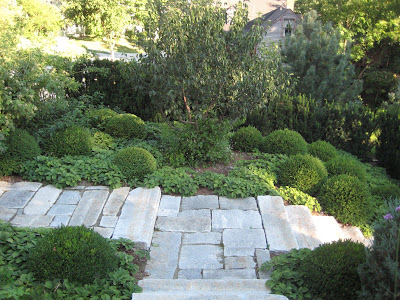
The Jewel Basin From Mount Aeneas

The Picnic Lakes

Mountain Goats Near Mount Aeneas Summit

Winding Pathway

Subalpine Fir Abies lasiocarpa Along Trail

Another Subalpine Trail

Field of Glacier Lily Erythronium grandiflorum

Naturalized Alpine daisies

Herbaceous Clematis
Last week we visited my wife's relatives who have a house on Swan Lake near Bigfork, Montana. It was my first trip to Montana and I fell in love with this region of the state just south of Glacier National Park. We spent a lot of time on the lake kayaking, tubing and water skiing but my favorite part of the trip was hiking in the Jewel Basin in Flathead National Park Wilderness Area about a half hour drive from the house.
The Jewel Basin gets its name because the high alpine lakes that circle the basin form what looks like a jewel necklace from the air. There was quite a bit of snow still on the ground and it reminded me of hiking in New Hampshire in April. July is the best month to observe the wildflowers of this subalpine habitat. The most common flower I encountered was the bright yellow glacier lily, Erythronium grandiflorum. I often saw it in great masses in fields and drifts along the trails leading to the summit of Mount Aeneas. The green corn lily, Veratrum viride, with its wide pleated green foliage, was a wonderful contrast to the bold architectural tufts glaucous leaves of the ubiquitous bear grass (actually in the lily family) Xerophyllum tenax.
What fascinated me most was the distribution of large drifts of perennials on a small scale and the subalpine fir, Abies lasiocarpa, on a grand scale. There was much to inspire me as I continue to develop the so-called wild garden in the lower level of my garden. I am particularly interested in foliage textures rather than the ephemeral beauty of flowers which are fleeting. The plantsmen in me tends to collect small numbers of a large variety of plants which ends up looking fussy and contrived.
When I returned to Peterborough, I saw the wild garden with new eyes and realized I want to have greater masses, but fewer species, of plants with interesting textures. I can't use the exact species that I observed in the Jewel Basin but I can try to replicate the feeling they evoked. I plan to relocate several of the spruce trees, Picea orientalis 'Gowdy', to form a more natural pattern like the one I observed with the subalpine fir but this time on a much smaller scale.
The recent drought has actually been fortuitous because it has prompted me to remove plants that pouted, like Veronicastrum virginicum, for example, while I was away. I will add more of the very tough but beautiful Trachystemon orientalis and larger drifts of epimediums and hellebores. I will most likely remove the stunted sourwood, Oxydendrum arboreum, and replace it with another silverbell, Halesia tetrapetala 'U. Conn. Wedding Bells', which has survived admirably. The search is now on for interesting plants that make the grade for a mass planting and are well-adapted to the dry woodland that I am creating.





























